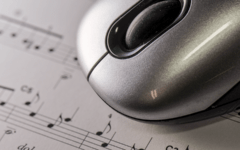
If you want to be a rock god or chord master, or simply need a new hobby, you might be thinking about trying to learn to play the guitar. But lessons can be expensive – and who has the time? Many people are finding success teaching themselves to play the guitar, and they do it all online. There are many websites, courses, apps, and online teachers out there waiting to help you, and we’ll show you how to find all of these great resources.
5 steps to getting ready to learn the guitar online
1. Decide if you want to learn on acoustic or electric guitar.
Unlike with many other types of instruments, with the guitar, you have a choice about which style you want to learn on: acoustic or electric. Acoustic guitars are wooden and hollow, which gives the music that classic folksy sound. Electric guitars are made from solid wood, metals, plastics, and other harder material. They also must often be plugged into amplifiers to make any noticeable sound.

To choose which one is right for you, you should think about the type of music you want to play. If you like the sound of soft music, country twang, folksy songs, or anything similar, then acoustic is probably for you. If love hard rock, heavy metal, and the sound of streaming guitars, then definitely go for electric. Many people choose to learn on acoustic first, as it helps you gain a more well-rounded set of skills related to the guitar. These skills can easily be transferred to learning electric guitar later on (or simultaneously).
2. Gain access to a guitar: buy one, borrow one, or rent one.
Once you’ve chosen the type of guitar you want to learn on, you need to acquire one! You might already have one around the house, but if you don’t, guitars can be quite pricey. If you’re just starting out and aren’t sure you’re ready to drop $900 on a Fender Stratocaster, you may want to consider some cheaper options. After all, you can always buy your dream guitar later on when you’ve mastered the craft!
Check out this Epiphone acoustic guitar or this electric guitar and amp on Amazon for a reasonable option if you have to purchase the guitar yourself. Renting the guitar is another option if you need to budget weekly to pay for your guitar, so check out your local music store for rates.
Unfortunately, it’s impossible to learn to play the guitar without actually having one, as your finger muscles need to get used to the motions of playing, so make sure you get a guitar before you try to start learning online.
3. Get the accessories you need for your guitar.
Alright, you’ve got the axe to play on and the drive to learn, but what else do you need? We’ve got a shopping list below to get you started. Some items are optional, while others are necessary.
Picks
Necessary
Picks are absolutely necessary to playing the guitar. They are required for any kind of precise playing, and help give your strumming hand a bit of a break. Luckily, picks are extremely cheap; you can usually find large quantities of them, in a variety of colors and designs, for only a few dollars. There are 3 standard levels of pick density: thin (under 0.40 mm – 0.63 mm), medium (0.63 mm – 0.85 mm), and heavy (0.85 mm – 1.22 mm and above).
Make sure you try out the various types to choose the right one for you and your style, and check out these best-selling picks on Amazon if you need a place to start.
Capo
Optional
A capo is a small rubber and metal/plastic clamp that you place on the neck of your guitar on top of one of the frets. This brings the ‘start’ of the neck down to the placement of the capo, meaning all of the notes are shifted down the number of frets you have now covered with the capo. This gives the notes you play a higher sound, and is required for playing some songs – though you can usually get by without it.

Tuner
Necessary
A tuner is necessary if you’re just starting out, as you won’t be experienced enough yet to tune your guitar by ear. Tuners can be purchased from any music supply store for a relatively cheap price. But thanks to today’s technology, you can also download guitar tuners like this one from app stores for free.
Android device tuners | iOS guitar tuners
Protective case and carrying bag
Necessary – if you’re on the move a lot
If you like to move around while playing your guitar, or will be taking it outside of your home, purchasing a protective case is a necessity. Guitars are fragile and easily damaged – and the damage shows. Even a small scratch can cost up to $100 to fix, as guitars are all hand-crafted and require a lot of work to make or repair. If a guitar is dropped, you can bet that it will be costly to fix, so make sure you get a protective case as your insurance policy.
Guitar stand
Optional, but highly recommended
If you keep your guitar at home and don’t move around a lot with it, you may not need a case. You will, however, need a guitar stand. A stand holds and cushions your guitar, and presents it nicely in your room. It also makes it easier to access your guitar whenever you want to pick it up and play it. If you don’t have a stand, your guitar is more likely to fall over and get damaged.
If you’re looking for a reliable stand that won’t break the bank, we’d recommend this one.
Strap
Optional (unless you love to play standing or want to be a performer)
Straps attach to two points on your guitar and then wrap around one of your shoulders, so you can play your guitar while standing. If you are considering any kind of formal performing, or simply like walking around or standing while playing, you need to get yourself a strap. They’re also a great way to express your personality, as they come in tons of custom colors, patterns, and designs!

Slide
Optional
A guitar slide is a fun little accessory that you can use to give your playing a unique sound. Typically made out of glass or metal, a slide is a cylinder that you place around one of your playing fingers. As you play, you can easily slide it down the strings, giving you an awesome sound. If you want to see one in practice, check out this YouTube video.
Backup strings
Optional
Though you’ll need a set of stings for your guitar when you buy it, you may want to think about buying a set of backup strings. Guitar strings don’t last forever; they wear out over time, and some eventually snap. This isn’t that uncommon for one or two of the higher-note strings, simply because they are stretched much more tightly than the lower-note strings. Having a backup set prevents you from having to stop practicing for a few days if a string snaps or they wear out.
Amplifier
Optional
If you’re buying an electric guitar, this is almost a requirement. Electric guitar strings will still sound when you pluck them, but if your guitar isn’t plugged into an amplifier, they won’t be very loud. This can make it extremely difficult for you to practice and improve your playing. In addition, some acoustic guitars can be built with a hookup for electric amplifiers, so you can hear your acoustic sound amplified while playing as well. This is something you may want to consider if you’re going to be a performer.
Amps are hard to shop for, and can sometimes be really expensive. If you want a deal, try entering into an auction on eBay for a guitar amp.
Pedals and pickups
Optional
These are some advanced guitar accessories, and probably not worth worrying about if you’re just learning how to play. But down the road, you may want to consider purchasing some pedals and pickups if you’re into electric guitar (and especially rock music). They can help you modify and customize your playing, and give you that unique sound that will set you apart from every other run-of-the-mill guitar player.

4. Find an online instructional method that suits you, based on your learning style.
So you’ve got all the equipment ready – it’s time to start learning! But where do you start? There are so many different ways you could go about learning music online, so we’ve broken down some of the main ones for you. Think about how you like to learn, and then choose which type(s) of instruction would be best for you.
Live video lessons with online teachers
There are websites out there that help connect budding guitar students with experienced instructors who carry out lessons via live Internet chat. You can search for a teacher that has the experience you want, is in your price range, and fits your schedule. Then you can sign up for online lessons and complete them based on your own schedule (and the availability of the instructor). You can also get great feedback instantly as you play – just as you would with an in-person lesson.
If you need to find a guitar teacher, give our article on the best online music teachers a read; it will help you find the right site for you. But if you’re eager, a website like LessonFace.com can help you find a guitar teacher right now!
Sound-detection apps that give you feedback
There are apps out there that can teach you to play guitar; some can even listen along as you play and comment on your accuracy and skill level. With built-in sound-detection technology, these apps are a great alternative to traditional music teachers, as you can learn entirely at your own pace.

If you’re interested, we’d recommend checking out Uberchord or Yousician, which both let you download them, work through tutorials, and learn songs – for free! They also offer in-app purchases for premium lessons on popular songs that you may decide you want to learn. These apps let you take charge of your own learning, but have such interactive and fun components that it won’t even feel like work!
Online courses and tutorials
If the apps are a little too much for you, you might consider an online course or series of tutorials. These lessons often have many visuals, diagrams, and quizzes to test your progress. You can also often contact instructors or other learners if you need help. Some websites, like Coursera, can teach you for free, while others, like Udemy, have dozens of courses for very reasonable prices (typically $10-20).
You’re already working hard at learning guitar; you don’t have time to learn how to use a new website from trial-and-error! If you need some help, check out our free tutorials on how to use Coursera and how to use Udemy.
A primarily text-based course on music theory
Learning guitar strictly from music theory isn’t for everyone, as it requires a lot of reading and is difficult to understand if you have absolutely no background in music studies. However, it is possible to teach yourself to play the guitar from reading up on music theory and understanding how the different parts of a guitar work. Then, you can apply what you’ve learned to practicing your instrument.

There are a few drawbacks to this method, though. You don’t get to interact with anyone with guitar experience, so you can’t really ask any questions. You also can’t get any feedback on your playing, so you may not know if you’re doing something wrong. However, if you already know how to play other instruments, this learning style can be a great starting point for helping you gain a more thorough understanding of music in general. This will make you a better guitar player down the road.
If you’re thinking about choosing this method, check out our article on how to learn music theory online.
5. Set aside a regular time to start practicing.
Once you’ve chosen a learning method, you need to set time aside to start practicing. It’s best for you to select a specific time each week that you will dedicate to practicing guitar. That way, you’ll have regular times to work, and won’t ever go too long without playing.
If you’re serious about learning, it’s best to practice each day. This is the most effective way to improve your skills and knowledge base, especially when learning new songs. Repetition and muscle memory will help you remember the notes, so practicing a song over and over each day will help you nail it much faster.
10 things to learn when studying guitar online
1. Basic music theory
When you’re starting out, it’s important not to ignore your music theory. This is the basis upon which all of your learning will be built. Understanding how to read notes and other elements of music is important, especially for the guitar. However, some people who play guitar never learn how to read music, choosing to learn how to read tabs instead (which we’ll explain about below).

2. Components of the guitar: strings, frets, neck
When you start learning, you can’t just jump right into songs. You need to learn about the parts of the guitar and how they all work together. Once you get this down, you’ll be able to understand how to actually play your guitar.
3. How to tune your guitar
When you’re ready to strum on the strings, you need to make sure your guitar is in tune. You can use one of the app tuners we mentioned above, or you can buy yourself a physical one. Make sure you tune your guitar each time you use it (before you play), or you won’t be able to recognize when you’re making errors. That can really hurt your learning progress.
4. Basic chords
A good first step to actually playing guitar is learning to play some basic chords. You should start out learning to play G, C, D, and E-minor; there are tons of songs you can play with only these 4 chords. If you want proof, check out this guitar player’s song montage using only these 4 chords.
5. Scales
Scales are important to learn, as they help you down the road when you want to compose your own music. Scales are the foundations of building chords and progressions; if you know your scales, you can create beautiful melodies. You can also improvise with solos much more effectively than people who don’t bother learning their scales.
6. Power chords
Power chords (or fifth chords) are especially useful to learn if you’re into electric guitar. Power chords are used in many popular songs, and are very easy to learn. However, they bring a depth and power to your music that simple chord progressions just don’t.
7. How to read guitar sheet music
Learning to read sheet music is key to becoming a talented musician. However, because of the availability of guitar tabs (see below), many new guitar players don’t bother to learn how to read sheet music. Though tabs are useful and don’t require knowledge of music theory to read, if you’re serious about becoming a musician, learning how to read sheet music isn’t a step you can skip.
8. Where to find great guitar tabs
If you’re not confident enough to try reading sheet music yet, guitar tabs are an easy solution for learning to play popular songs. A “tab” (short for guitar tablature) is a way to read music without actual notes. Instead of notes on a staff, tabs show the 6 strings of a guitar and the fret(s) you should play on. Anyone who understands how strings and frets work can read tabs, and in turn, can learn to play any song that has been transposed into a tab.

If you’re looking for a place to get free and accurate tabs, check out Ultimate-Guitar.com. Users upload their own tabs, so they aren’t guaranteed to be accurate, but the users on Ultimate Guitar are fairly active in making comments about tab accuracy. There are also usually dozens of versions of the tab to choose from! Each tab is also rated, so you can get an idea of how accurate it is before you even open it.
9. Some songs to play for your friends and family
Once you have some of the basics down, make sure you try learning some songs! It’s very rewarding to learn songs you know, especially your favorites. And playing them for friends and family is a great way to gain confidence in your abilities! Start out with some basic songs that are easy to play, like “Smoke on the Water” by Deep Purple or “Free Fallin’” by Tom Petty. These songs require only basic chord progressions and movements, so they should be easy to learn.
10. Fancy techniques: sliding, whammy, etc.
Once you’ve learned a few songs, you might want to look into how to use more advanced techniques. These include sliding, whammying, hammer-ons, pull-offs, harmonics, sweep picking, tapping, legato, and more! If you want to try out some exercises to improve your overall playing, including speed and accuracy, then check out this great site.
Tips for learning the guitar online
1. Practice makes perfect.
Nothing is going to make you better at playing guitar than practicing and playing your instrument as often as possible. When learning songs, you must play them over and over (even if you’re doing it perfectly) to remember them in the future. You may be able to nail a song one day, but if you then let a month go by without playing it, chances are that you won’t remember every part.
If you want to become great at playing the songs you love, you should consider playing in front of other people. Try performing your songs for some trusted friends, or even other guitar players that can give you helpful and constructive criticism. This is a great way to improve your confidence, and it can also help you identify the sections of songs you most need to work on.
2. If you’re struggling, try learning in a different way.
If you’re in a bit of a rut with the method you chose for learning guitar, try switching it up. Choose another method and try learning or improving your skills in a different way. Changing it up will help keep you focused and motivated, rather than getting bored, frustrated, or discouraged with a method that isn’t working for you.
3. If you have questions, try reaching out to an experienced player.
Learning guitar online by yourself can be a real challenge. It’s hard to know what you should be doing, stick to your own schedule, and recognize when you’re making mistakes. If you have questions, try reaching out to someone who can help. Whether it’s someone you know or someone you find online through your courses, videos, or instructors, getting another guitar player’s opinion can make a huge difference to your success.
4. Learning a new song is one of the best ways to improve.
Always keep thinking of new songs you’re interested in mastering. This is one of the best ways to improve your skills – not to mention one of the most fun ones! It’s good to keep a running list of songs you’re thinking about learning. Then, when the mood strikes you, sit down and start learning one. Remember to always go back and practice your old songs, too, to prevent yourself from forgetting them.
5. There are many different styles of guitar playing, but you don’t need to learn them all.
Remember that each guitar player is unique. No two people learn to play guitar in the exact same way, nor are they interested in learning the same songs and styles. You can always switch up your rhythm, work with different genres, and learn new techniques that go along with each style. If you want to learn some country twang, pick up a slide. If you want to create some smooth jazz, try working on your scales. If you want to master the rock game, work on your hammer-ons, pull-offs, and legato-style playing.
We hope that helps you get on your way to mastering the guitar! Be sure to check out the rest of our website, where we have a series of articles about learning to play music online (including how to play the piano). Remember, learning guitar takes time, practice, and dedication, so if you’re feeling like giving up, try a different approach. You might just find some more inspiration to keep you going!
[Banner Image Credit: Gavin Whitner at MusicOomph.com]






